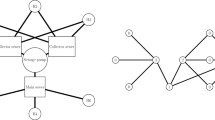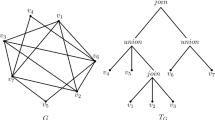Abstract
Given a graph \(G=(V,E)\), a function \(f:V\longrightarrow \{0,1,2,3\}\) is called a double Roman dominating function on G if (i) for every \(v\in V\) with \(f(v)=0\), there are at least two neighbors of v that are assigned 2 under f or at least a neighbor of v that is assigned 3 under f, and (ii) for every vertex v with \(f(v)=1\), there is at least one neighbor w of v with \(f(w)\ge 2\). The weight of a double Roman dominating function f is \(f(V)=\sum _{u\in V}f(u)\). The double Roman domination number of G, denoted by \(\gamma _{dR}(G)\) is the minimum weight of a double Roman dominating function on G. For a graph \(G=(V,E)\), Min-Double-RDF is to find a double Roman dominating function f with \(f(V)=\gamma _{dR}(G)\). The decision version of Min-Double-RDF is shown to be NP-complete for chordal graphs and bipartite graphs. In this paper, we first strengthen the known NP-completeness of the decision version of Min-Double-RDF by showing that the decision version of Min-Double-RDF remains NP-complete for undirected path graphs, chordal bipartite graphs, and circle graphs. We then present linear time algorithms for computing the double Roman domination number in proper interval graphs and block graphs. We then discuss on the approximability of Min-Double-RDF and present a 2-approximation algorithm in 3-regular bipartite graphs.







Similar content being viewed by others
References
Ahangar HA, Chellali M, Sheikholeslami SM (2017) On the double Roman domination in graphs. Discrete Appl Math 232:1–7
Ahangar HA, Chellali M, Sheikholeslami SM (2019) Signed double Roman domination in graphs. Discrete Appl Math 257:1–11
Ahangar HA, Henning MA, Löwenstein C, Zhao Y, Samodivkin V (2014) Signed Roman domination in graphs. J Comb Optim 27:241–255
Aho AV, Hopcroft JE, Ullman JD (1974) The design and analysis of computer algorithms. Addison-Wesley, Boston
Alimonti P, Kann V (1997) Hardness of approximating problems on cubic graphs. In: Proceedings of 3rd Italian conference on algorithms and complexity, Rome, Lect Notes in Comput Sc 1203:288–298
Amjadi J, Nazari-Moghaddam S, Sheikholeslami SM, Volkmann L (2018) An upper bound on the double Roman domination number. J Comb Optim 36(1):81–89
Anu V, Lakshmanan SA (2018) Double Roman domination number. Discrete Appl Math 244:198–204
Ausiello G, Crescenzi P, Gambosi G, Kann V, Marchetti-Spaccamela A, Protasi M (1999) Complexity and approximation : combinatorial optimization problems and their approximability properties. Springer, Berlin
Beeler RA, Haynes TW, Hedetniemi ST (2016) Double Roman domination. Discrete Appl Math 211:23–29
Booth KS, Johnson JH (1974) Dominating sets in chordal graphs. SIAM J Comput 9:205–212
Chellali M, Haynes TW, Hedetniemi ST, MacRae A (2016) Roman \(\{2\}\)-domination. Discrete Appl Math 204:22–28
Chvátal V (1979) A greedy heuristic for the set covering problem. Math Oper Res 4:233–235
Cockayne EJ, Dreyer PA, Hedetniemi SM, Hedetniemi ST (2004) Roman domination in graphs. Discrete Math 278:11–22
Dinur I, Steurer D (2014) Analytical approach to parallel repetition. In: Proceedings of symposium on theory of computing, STOC, 2014, pp 624–633
Haynes TW, Hedetniemi ST, Slater PJ (eds) (1998a) Domination in graphs: advanced topics. Marcel Dekker Inc, New York
Haynes TW, Hedetniemi ST, Slater PJ (1998b) Fundamentals of domination in graphs. Marcel Dekker Inc, New York
Henning MA, Hedetniemi ST (2003) Defending the Roman empire-a new strategy. Discrete Math 266:239–251
Henning MA, Rad N (2019) A characterization of double Roman trees. Discrete Appl Math 259:100–111
Jamison RE, Laskar RC (1982) Elimination orderings of chordal graphs. Combinatorics and Applications, Calcutta, 1982. ISI, Calcutta, pp 192–200
Keil JM (1993) The complexity of domination problems in circle graphs. Discrete Appl Math 42:51–63
Müller H, Brandstädt A (1987) The NP-completeness of STEINER TREE and DOMINATING SET for chordal bipartite graphs. Theoret Comput Sci 53:257–265
Mojdeh DA, Parsian A, Masoumi I (2017) Bounds on double Roman domination number of graphs. In: Proceedings of the 2nd international conference on combinatorics, cryptography and computation (I4C2017)
Panda BS, Das SK (2003) A linear time recognition algorithm for proper interval graphs. Inf Process Lett 87:153–161
Rad NJ, Rahbani H (2019) Some progress on double Roman domination in graphs. Discuss Math Graph Theory 39(1):41–53
ReVelle CS, Rosing KE (2000) Defendens imperium romanum: a classical problem in military strategy. Am Math Monthly 107:585–594
Shao Z, Sheikholeslami SM, Nazari-Moghaddam S, Wang S (2019) Global double Roman domination in graphs. J Discrete Math Sci Crytogr 22(1):31–44
Stewart I (1999) Defend the Roman empire!. Sci Am 281:136–139
Volkmann L (2018) Double Roman domination and domatic numbers of graphs. Commun Comb Optim 3(1):71–77
Yen CC, Lee RCT (1996) The weighted perfect domination problem and its variants. Discrete Appl Math 66:147–160
Yue J, Wei M, Li M, Liu G (2018) On the double Roman domination of graphs. Appl Math Comput 338:669–675
Zhang X, Li Z, Jiang H, Shao Z (2018) Double Roman domination in trees. Inf Process Lett 134:31–34
Acknowledgements
The authors would like to thank the anonymous referee for his/her comments that lead to improvements in the paper. The research of the second author is supported in part by the University of Johannesburg. The research of the third author is supported in part by DST-SERB (MATRICS) project.
Author information
Authors and Affiliations
Corresponding author
Additional information
Publisher's Note
Springer Nature remains neutral with regard to jurisdictional claims in published maps and institutional affiliations.
Rights and permissions
About this article
Cite this article
Banerjee, S., Henning, M.A. & Pradhan, D. Algorithmic results on double Roman domination in graphs. J Comb Optim 39, 90–114 (2020). https://doi.org/10.1007/s10878-019-00457-3
Published:
Issue Date:
DOI: https://doi.org/10.1007/s10878-019-00457-3




